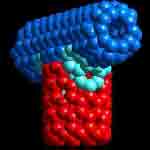|
By : Jim Pinto, The commercial interest in nanotechnology is being driven by visions of a stream of commercial products and applications that will lead to a new industrial revolution. Some significant nanotech products are already on the market.

Automation.com, November 2003
|
 Business Week recently named Nanotechnology one of the Ten Technologies That Will Change Our Lives. The commercial interest in nanotechnology is being driven by visions of a stream of new nanotech commercial products and applications that will lead to a new industrial revolution - a revolution in which almost every industry is likely to be affected.
Business Week recently named Nanotechnology one of the Ten Technologies That Will Change Our Lives. The commercial interest in nanotechnology is being driven by visions of a stream of new nanotech commercial products and applications that will lead to a new industrial revolution - a revolution in which almost every industry is likely to be affected.
Small dimensions, big differencesWhen we get down to nanometer dimensions, the classical laws of physics change. Once atomic size particles can be manipulated, it will be possible to produce new materials with desired properties: smaller, stronger, tougher, lighter and more resilient than anything that has ever been made.The properties of materials that we notice - color, hardness, electrical and thermal conductivity and so on - all depend on the nature and structure of atoms and molecules. With increasing ability to design and build on an atomic and molecular scale, better and better materials are being developed, with entirely new properties. Those materials, in turn, become the building blocks for more complex systems and entirely new products. With nanotech, today's supercomputer could become tomorrow's wristwatch PDA. Buildings and machines could signal when they need maintenance - and perhaps repair themselves. Our clothing could monitor our health and alert us to environmental hazards. All of these marvels, and many more, are scientifically possible. The difficulty is to figure out how and when these things will happen. Practical nanotech materialsIt turns out that commonly used materials take on entirely different characteristics when "assembled" at a molecular level. So, even today, the biggest nanotech market is in materials. The use of nanosize particles in products such as cosmetics, sunscreen, paints and a host of other products is already commonplace. Many specialized nanotech startups are already emerging and whole new industries will grow up around them.Right now, for example, there are lots of startups selling carbon nanotubes, the strongest and most conductive fibers known. Molecule-size components are being assembled into complex composites and "smart" materials. For example, nanostructured membranes are being developed for efficient filtering of pollutants from water or air. New gadgets galoreMore than anything else, the commercial possibilities for new products are truly exciting. There are huge applications for tiny, inexpensive nanosensors - from medical diagnostics, to chemical and biohazard detection, to vast arrays of wireless networks.IBM has already shipped more than 5 million disk drives with a new nanostructured magnetic coating (referred to as “pixie dust”) which quadruples the data storage. But, as the components shrink, manufacturing costs increase, and there are physical limits to the minimum size of a useful silicon transistor or the data storage density of a magnetic disk. So totally new nanotech devices are being explored to process and store information. Carbon nanotube transistors can be made smaller than any possible silicon transistor, with far better performance. And other new ways of storing information are also being explored. For example, a nanomechanical system called “Millipede” stores data as tiny, erasable indentations in a thin plastic film; this could allow trillion of bits of information to fit within a chip that could be used in a wristwatch PDA. Near term NanotechSome of these materials and products are still in the laboratory, just future visions. How about the near-term? Here are just some of the real nanotech products that are already on the market:
Here is Atkinson’s list of products and applications that are coming short-term - 2 to 5 years:
Nanotech is NOT far off - within a decade it will have huge effects on manufacturing, health care, energy, agriculture, communications, transportation, and electronics; it will be a $1 trillion business and will create 2 million new jobs. Read these books to get with it! Find out how nanotech will revolutionize YOUR markets, with applications in YOUR business! Related Links: 
|
Return to Index of all JimPinto Writings

 Return to JimPinto.com HomePage
Return to JimPinto.com HomePage
If you have ideas or suggestions to improve this site, contact: webmaster@jimpinto.com
Copyright 2003 : Jim Pinto, San Diego, CA, USA
